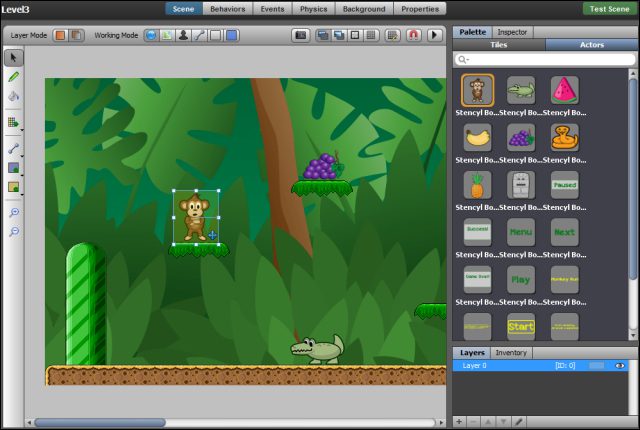

Results obtained endorse the concept and the hypothesis of its easiness of use and demonstrate the engine potential.

To test it, users with little experience in programming have developed arcade games using the presented environment as a proof of its easiness with respect to other comparable software. Some experiments have been designed in order to validate its ease of use and its capacity in the creation of a wide variety of games. The engine presented here allows the behaviour of the game objects to be defined using a very small set of conditions and actions, without the need to use complex data structures. The game specification has been simplified, decreasing the complexity of the engine architecture and introducing a very easy-to-use editing environment for game creation. This paper presents a new 2D game engine that reduces the complexity of video game development processes. Nevertheless, most game development environments rely on the traditional way of programming and need advanced technical skills, even despite today’s improvements. The development of these interactive applications is on its way to becoming democratized, so that anyone who is interested, without any advanced knowledge of programming, can create them for devices such as mobile phones or consoles. In recent years, the increasing popularity of casual games for mobile and web has promoted the development of new editors to make video games easier to create. No entanto, os resultados demonstram também primeiros indícios da viabilidade e da contribuição positiva da formação continuada de professores para o ensino de computação, contribuindo para a popularização dessas competências.

Observa-se que, devido à falta de informações sobre como as UI foram desenvolvidas, há oportunidades de pesquisas futuras nessa área. As UI encontradas variam amplamente em termos de modo de ensino e duração. A maioria das UI se concentra no ensino de algoritmos e programação, com poucas cobrindo também o conhecimento pedagógico e tecnológico. Neste contexto, o artigo apresenta um mapeamento sistemático visando a identificação de unidades instrucionais (UI) existentes para formação continuada de professores e suas características. Por isso, algumas iniciativas visam integrar a formação em computação de maneira interdisciplinar, voltada a professores de outras áreas por meio de formação continuada. Essa integração do ensino de computação na escola requer professores formados, no entanto, atualmente poucos se formam em cursos de licenciatura em computação. Devido a essa importância, o ensino da computação deveria ser iniciado já na Educação Básica. Advisor: Leen-Kiat SohĪtualmente, a computação mostra-se cada vez mais influente no nosso dia-a-dia. Results will help inform K-12 CS PD program design.
#STENCYL GAME ENGINE HOW TO#
Findings showed the PD program had a significant impact on the teachers, there was a positive correlation between teachers’ pre-program confidence and knowledge, and additional insights on how to deliver such PD programs more effectively. Statistical and SWOT analyses were then performed using measures such as attitudinal surveys and knowledge assessments. Two courses designed to train K-12 teachers to teach CS, focusing on both concepts and pedagogy skills were taught over two separate summers to two separate cohorts of teachers.
#STENCYL GAME ENGINE PROFESSIONAL#
Comprehensive research was carried out to investigate and understand the influence of a summer two-week professional development (PD) program on teachers’ CS content and pedagogical knowledge, their confidence in such knowledge, their interest in and perceived value of CS, and the factors influencing such impacts. The demand for K-12 Computer Science (CS) education is growing and there is not an adequate number of educators to match the demand.


 0 kommentar(er)
0 kommentar(er)
